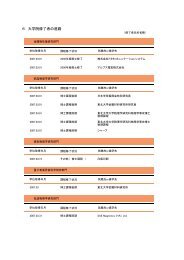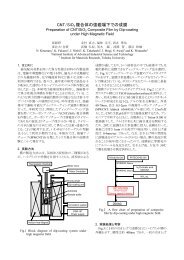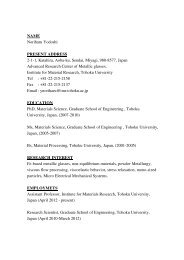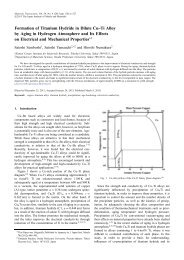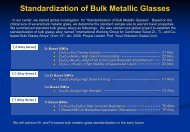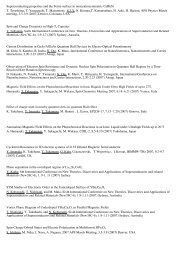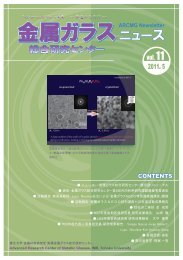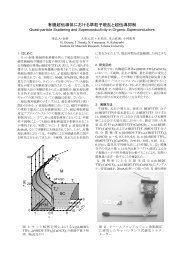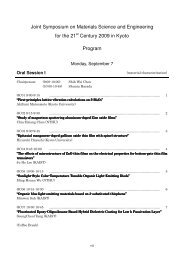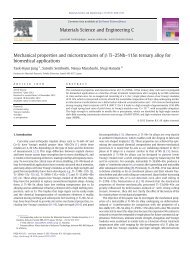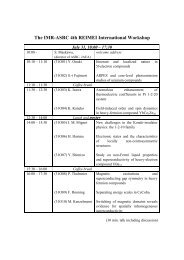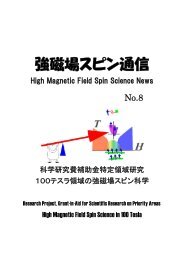ARCMG Newsletter - éå±ã¬ã©ã¹ - æ±å大å¦
ARCMG Newsletter - éå±ã¬ã©ã¹ - æ±å大å¦
ARCMG Newsletter - éå±ã¬ã©ã¹ - æ±å大å¦
You also want an ePaper? Increase the reach of your titles
YUMPU automatically turns print PDFs into web optimized ePapers that Google loves.
金 属 ガラス 総 合 研 究 センターニュース Vol. 14<br />
Figure 5 The cycles to failure compared with the<br />
number of surface defects at various stress levels [1].<br />
Statistical<br />
fatigue-lifespf<br />
pan models are also<br />
developed to predict p the fatigue life off HEAs. The<br />
first model assumes a Weibull distribution to explain<br />
the fatigue-lifee span distribution in each<br />
fixed stress<br />
range. The probability density function (PDF) is<br />
shown by Eq. (1),(<br />
Fig. 3 S-N curve for the<br />
Al0.5CoCrCuFeNi HEAs<br />
showing scattering of the<br />
cycles to failure for the<br />
parallel and vertical type morphologies, respectively,<br />
in the sample [1].<br />
To determinee whether mircrostructrual morphologyy<br />
has an effect on the fatigue<br />
life, the microstructure of<br />
fatigue specimens are indentified by scanningg<br />
electron microscopy (SEM). Figure 3 shows thee<br />
fatigue behavior of the parallel and vertical types of<br />
samples. It appears thatt there is no correlationn<br />
between the scatter in the fatigue life and thee<br />
orientation of<br />
the loading direction resulted from thee<br />
different morphologies. The compositions of defectss<br />
in the sample<br />
are performed by EDS analyses, seenn<br />
in Figure 4. This feature shows the presence of aboutt<br />
50% oxygen, together with aluminum oxide particles,<br />
which provide<br />
nucleation sites for microcracks due too<br />
stress concentration at particles. The number of<br />
cycles to failure vs. the number of o defects iss<br />
presented in Figure 5. It can be found that a decreasee<br />
in the number<br />
of defects generally correlates with ann<br />
increase in the fatigue life at various stress levels.<br />
(1)<br />
where β is the Weibull shape parameter, and the<br />
Weibull scale parameter, α (S) , depends on the<br />
stress S according to,<br />
log( α ( S))<br />
= γ<br />
0<br />
+<br />
γ 1<br />
log( S)<br />
(2)<br />
The modeling values v of the three parameters are<br />
β = 0.492, γ00 = 70.869, andγ1= -8.327. Figure 6<br />
indicates the predicted p median, 0.025 quantile, and<br />
0. .975 quantile fatigue lives.<br />
Fig. 6 Predicted quantile lives using the Weibull<br />
predictive model [1].<br />
Fig. 4 SEM micrograph with EDS analyses of the<br />
aluminum-oxide particles. The compositions of the<br />
regions<br />
labeled A and B are given<br />
in the<br />
corresponding tables, indicating the presence of<br />
aluminum oxide particles [1].<br />
To characterize the excessive variability in the<br />
observed<br />
fatigue<br />
data, the Weibull<br />
mixture<br />
predictive model, which assumes a mixture of two<br />
Weibull distributions for the fatigue lives at each<br />
stress range value is used. The PDF is given in Eq.<br />
(3),<br />
f<br />
N(<br />
S)<br />
p,<br />
α ( S),<br />
, β , α ( S),<br />
β )<br />
= (3)<br />
(<br />
w<br />
βw<br />
N(<br />
S)<br />
p<br />
( )<br />
αw(<br />
S)<br />
α(<br />
S)<br />
W<br />
βw−1<br />
βs<br />
N<br />
( S)<br />
+<br />
(1 − p)<br />
( )<br />
αs(<br />
S)<br />
α<br />
s(<br />
S)<br />
s<br />
N(<br />
S)<br />
exp( −(<br />
)<br />
α ( S)<br />
βs−1<br />
w<br />
s<br />
βw<br />
N(<br />
S)<br />
βs<br />
exp( −(<br />
) )<br />
αs(<br />
S)<br />
)<br />
Again, the Weibull scale parameters,α<br />
, and,<br />
α<br />
s<br />
(S) , are assumed to be dependent on<br />
the stress S<br />
according to Eqs. (4) and (5))<br />
log(<br />
α<br />
w<br />
( S))<br />
= γ<br />
w, 0<br />
+ γ w<br />
log(<br />
S ) (4)<br />
log(<br />
α<br />
s<br />
( S))<br />
= γ s<br />
+ γ<br />
,1<br />
log(<br />
, 0 s<br />
S ) (5)<br />
, 1<br />
α<br />
ω<br />
(S)



